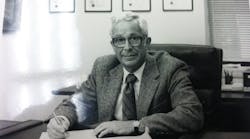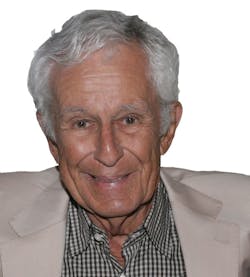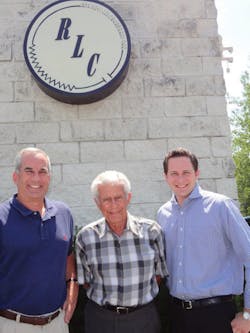Even in an industry full of larger-than-life characters, Charles Alan Borck stood out. He was known for demanding excellence from himself and those around him. Like many with that level of dedication, Alan put a lot of pressure on himself to do the best job he could. He was known for having that attitude in the industry—especially when it came to companies and individuals that partnered with him. Sadly, Alan passed away on March 1, 2013 at the age of 87.
When I started on Microwaves & RF, I was advised by a salesperson to “steel myself” before meeting with Alan for the first time. Alan had already told this salesperson exactly how he felt underserved by the magazine at least a couple of times, and Alan was not known for mincing words. Yet he was so intelligent—and his consistently high standards were so admirable—that we all had the utmost respect for him and gave great thought to his feedback.
Related Articles
• Interview: Eran Eshed, Co-Founder, Altair Semiconductor
• Interview: Jim Doyle, President and CEO of East Coast Microwave Distributors
• Interview: David J. Aldrich, President and Chief Executive Officer, Skyworks Solutions
Alan always let everyone know where they stood, which to me is a very refreshing quality. Like most people with a tough exterior, he had a heart of gold. In addition to his intelligence and direct manner, Alan was known for his dedication to his family—including his extended family at RLC Electronics, the company he founded back in 1959. Over the years, he dedicated himself to making the firm successful. In fact, he stayed involved in the company until his sudden passing earlier this year. Here, we look back at the legacy and life he built over his 87 years—and find out how the folks at RLC plan to honor that legacy.
NF: Alan graduated from Rensselaer Polytechnic Institute (RPI) in 1947 with a degree in electrical engineering, correct? I understand that he maintained a relationship with his alma mater through the years.
RLC: After graduating early from high school, his mother (Lillian) said that he was not to sit home andNF: What did he do upon graduating? And where did he work until he founded RLC?
RLC: Upon graduation, he went to work at ITT in Nutley, NJ with several other engineers, who later founded RF and microwave companies. Shortly afterward, he met Virginia Herson, the love of his life and the woman with whom he would spend the next 62 years. Shortly after their marriage, Alan left ITT and commuted weekly to Amsterdam, NY, where he worked for Empire Devices. He initially lived with the company’s owners, Joe Lorch and Mike Hargas, who founded the company in 1946. Joe went on to found Lorch Microwave (now part of Smiths Industries), which became a leading supplier of RF/microwave switches and filters and assemblies that combined both functions. In 1959, with three kids in tow, Alan felt unfulfilled with his current position. So he founded RLC Electronics and stayed involved in RLC until his passing.
NF: Even into his 80s, Alan was highly respected for his technical expertise. How did he maintain this edge and create such a legacy?
RLC: No one who ever did business with Alan Borck would ever consider him indecisive or indirect. While he was a man of few words, he always said what he believed to be the truth—like it or not. Alan was a stand-up guy and a very bright one as well. While the veterans of the RF and microwave industry may remember Alan as a hard-nosed businessman, no one is one-dimensional—certainly not Alan Borck, who valued family, hard work, accomplishment, honesty, loyalty, and respect for others.
RLC is in the genes. Capturing three generations, this photo shows Alan Borck with (l) Douglas Borck, President, and (r) Jeffrey Borck, Sales Manager.
NF: What was his relationship like with the staff?
RLC: It’s pretty amazing that this company has been family-run so successfully for over 50 years. Alan—or “Mr. Borck” as he was called by the staff—was loved, admired, respected, and appreciated by all of the RLC employees. Not a day went by where someone in the building didn’t stop to ask how he was doing. He was known for a tough-love approach, and that’s how everyone at RLC remembers him: tough on the outside, but loving and caring on the inside.
NF: What were Alan’s interests beyond RLC?
RLC: Alan was a great athlete and competitor. He was an avid skier, tennis player, and golfer. Later in life, he started playing bridge with that same competitive edge. He had many other hobbies, including biking, rollerblading (in his earlier years), and going to the gym. His biggest passion, aside from RLC, was his wife and family. He was a true family man, attending every sporting event (some as the coach), concert, and theatrical performance—and never missing a meal or holiday. He also loved to travel with his wife, Virginia, and with each of his seven grandchildren.
NF: What do you feel his legacy was—both personally and in the microwave industry?
RLC: Alan Borck’s legacy is the family that he raised with Virginia and his service to the RF and microwave industry through the establishment of a strong, vibrant company in RLC Electronics. Alan will be remembered by his friends and family. His legacy will be carried on by his three children, seven grandchildren, and 50 employees at RLC.
NF: Alan prided himself on his firm’s passive coaxial microwave components. What applications does RLC currently target—and with what products?
RLC: Typical applications for RLC products are for military and commercial use including telecommunications platforms, calibration services, automatic test equipment (ATE), and electronic warfare (EW). The firm’s products include coaxial switches, filters, attenuators, couplers, power dividers, detectors, bias tees, terminations, and other transmission-line components. RLC also has the ability to combine multiple functions in an integrated assembly per customer specific requirements.
NF: For one of the smaller companies in this industry, RLC is able to do quite a variety of products and assemblies, thanks to the plant that Alan created. Can you tell us a bit about it?
RLC: Sure. The plant combines areas for research and development, metal fabrication, assembly, quality control, environmental testing, and general and administrative offices in 20,000 square feet. Because RLC has its vertically integrated facility in Mt. Kisco, NY, cycle times for engineering models or prototypes are very short. Through cost containment, RLC is able to provide very competitive pricing.
NF: Can you explain RLC’s Qualified Products List (QPL) status for switches?
RLC: RLC is the only worldwide QPL switch provider. This means that the quality and reliability controls that are used to build QPL switches are incorporated into all of RLC’s switches.
NF: What current trends in the industry are impacting RLC’s internal R&D efforts?
RLC: There are two major trends that we are seeing in the industry: higher-frequency product demands and miniaturization. As a custom product provider, RLC continues to push higher in frequency, offering both switches and filters up to 65 GHz as well as other passive devices up to and beyond 40 GHz. We continue to react to the needs of our customers and will explore ways to continue pushing the barrier on frequency limitations. With regards to miniaturization, RLC is continuing to roll out surface-mount offerings across all product lines, as more and more customers are looking for small, lightweight surface-mount parts. These two areas will continue to shape RLC’s R&D efforts.
NF: Thank you for sharing a bit about Alan’s life and legacy with us. On behalf of Microwaves & RF and the microwave industry, we offer our deepest condolences to the Borck and RLC families.


